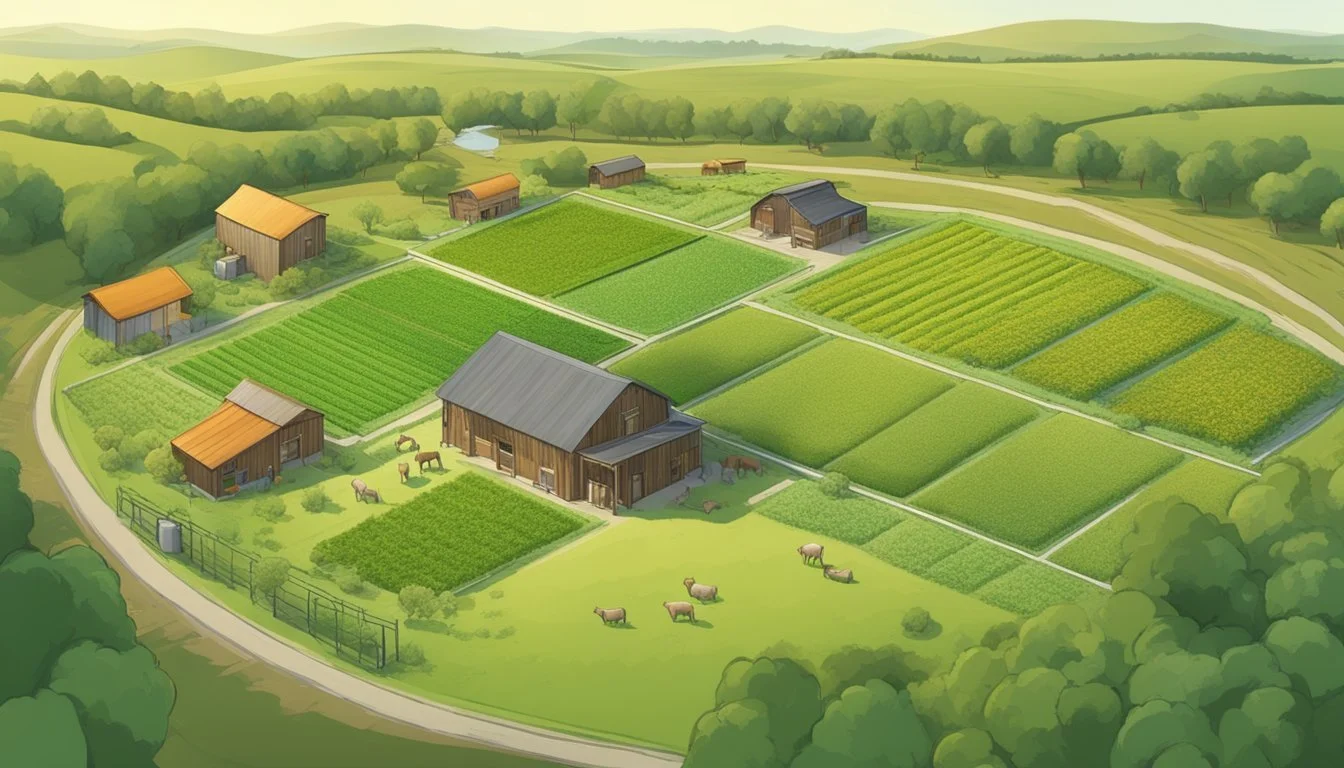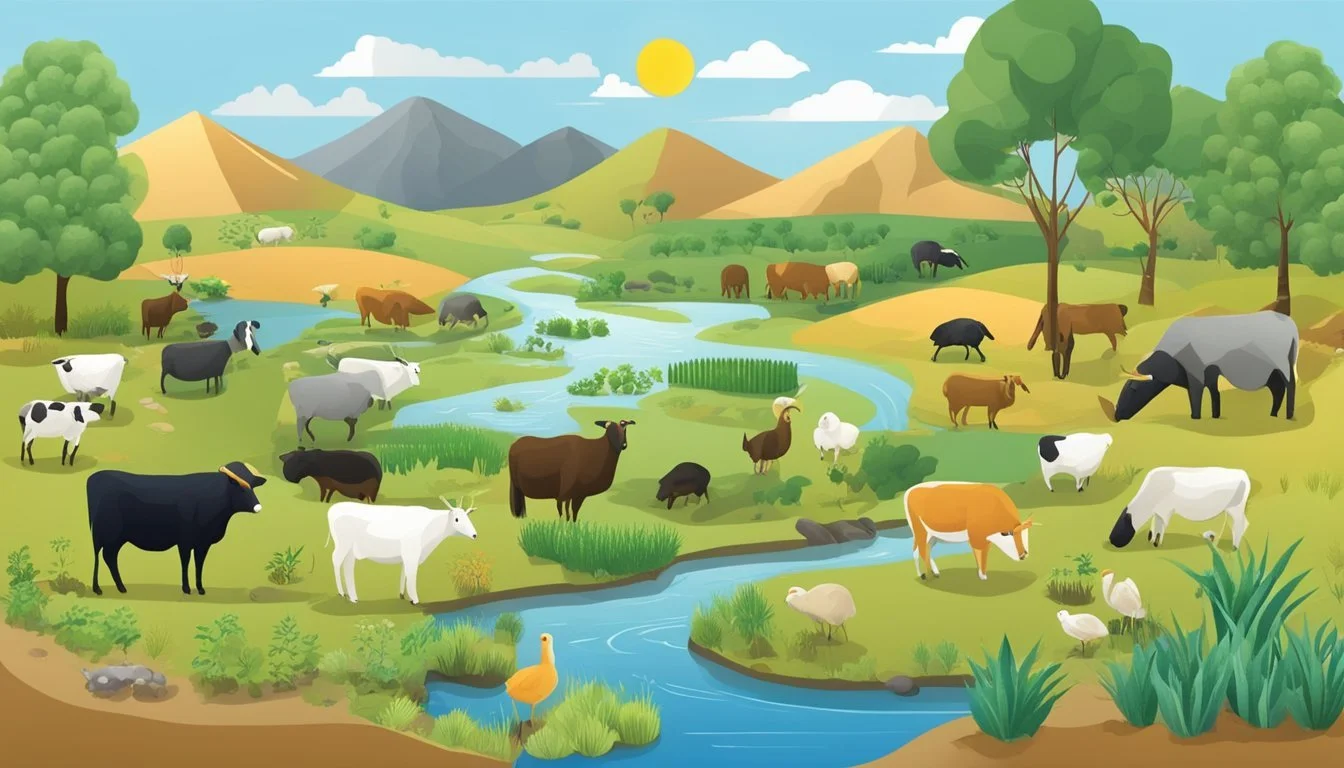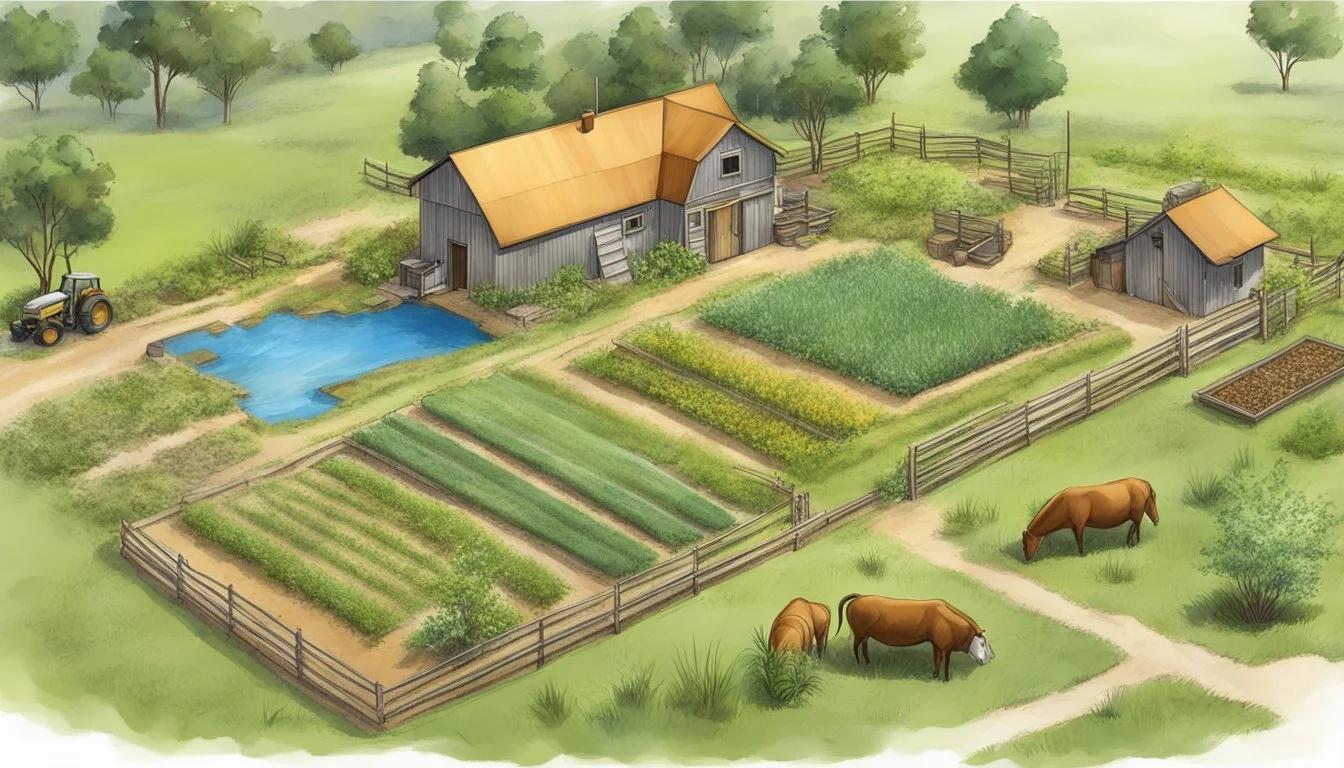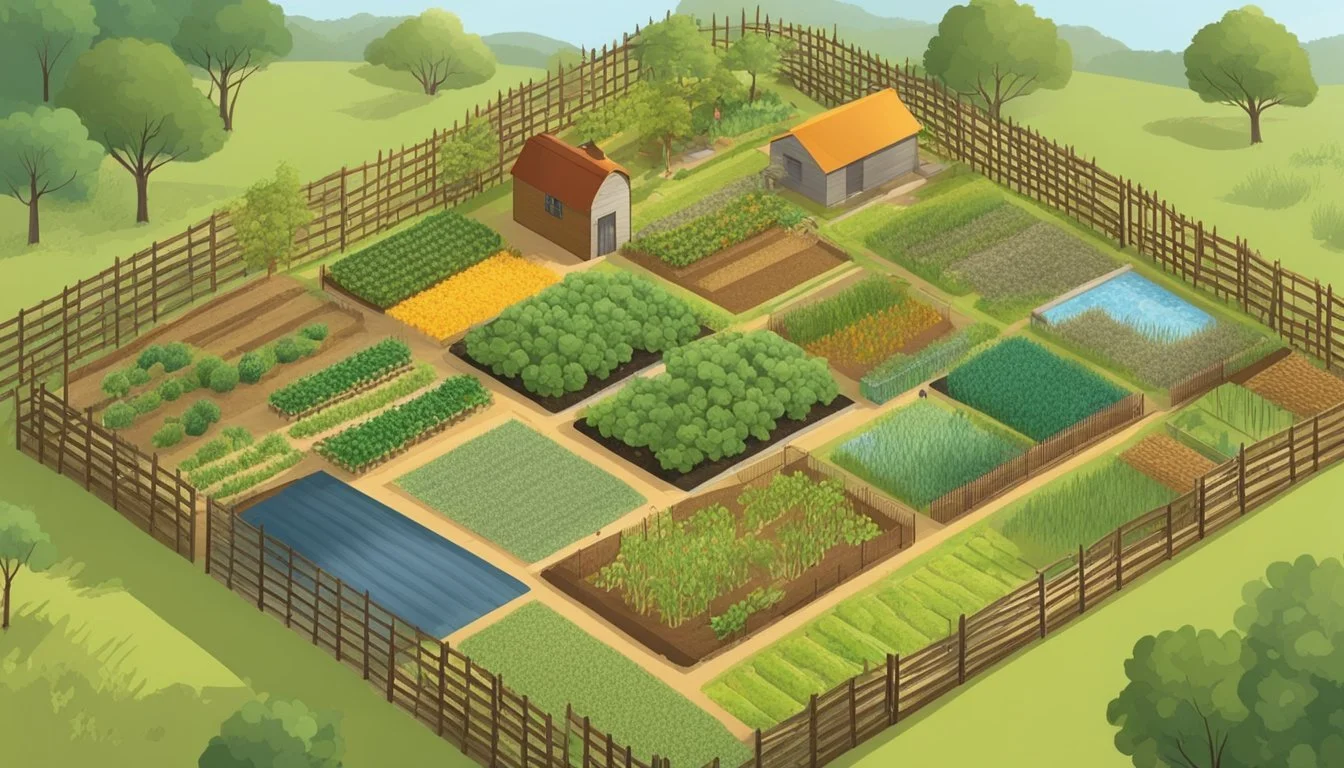The Principles of Holistic Management for Homesteaders
A Guide to Integrative Land Stewardship
Holistic management in homesteading offers a structured approach to managing resources that strives to mimic the complexity of nature. This system prioritizes goal setting, decision-making, and planning processes that consider the economic, ecological, and social aspects of the homestead. Homesteaders who adopt holistic management are equipped with the tools to make better-informed decisions that align with their values and vision for a sustainable lifestyle.
Homesteaders challenge the status quo by seeking a life that cultivates self-sufficiency and a deeper connection to the land. This pursuit is not just driven by the desire to grow food or raise livestock; it is underpinned by a philosophy that encourages living in harmony with the natural world. Holistic management empowers them to improve their land's health, increase productivity, and enhance their quality of life without sacrificing the integrity of their ecosystem.
Adopting the principles of holistic management requires a shift from traditional farming practices to a more conscious and regenerative approach. Through practices such as rotational grazing, diverse crop cultivation, and responsible water management, homesteaders strive for a balance that supports their goals while preserving the environment for future generations. With this approach, they can navigate the complexities of homesteading, from unpredictable weather patterns to market fluctuations, ensuring the resilience of their homestead against a backdrop of change.
Holistic Management Fundamentals
Holistic Management is a decision-making framework that enables farmers and land stewards to achieve sustainable economic, social, and environmental outcomes. It pivots on defining a holistic goal, which articulates the vision for the land, the life quality desired, and the forms of production to sustain this vision.
Holistic Goal Setting is the foundation, involving deep reflection and detailed description of the future one desires. The process encompasses:
Vision: Identifying the quality of life aspirations.
Ecosystem health: Describing the ideal state of the natural resources.
Financial viability: Defining profitability and economic objectives.
The Holistic Financial Planning component ensures that every financial decision aligns with the holistic goal. It is not merely about budgeting but about prioritizing expenses that lead toward the goal while ensuring the operation remains economically viable.
Planning is robust and dynamic, integrating both short-term and long-term strategies. It entails continuous monitoring, evaluating progress, and adapting as needed. The decision-making process is thus iterative, factoring in new information and changes in circumstances to guide adjustments that stay true to the holistic goal.
In regard to Holistic Management, it isn't just about livestock or crop production; it's about human goals and aspirations working harmoniously with agricultural and natural systems by focusing on these fundamentals, homesteaders position themselves better for success.
Understanding the Ecosystem
A healthy ecosystem is vital for sustainable homesteading, which integrates principles of ecosystem health, supports biodiversity and wildlife habitats, and focuses on the stewardship of soil and land management.
Principles of Ecosystem Health
The health of an ecosystem is gauged by its resilience, productivity, and the ability to cycle nutrients effectively. It encompasses soil fertility, which is essential for plant growth, and water infiltration, the soil's capability to absorb and store water. Effective resource management practices ensure that these processes are maintained, reducing soil erosion and promoting long-term sustainability.
Biodiversity and Wildlife Habitats
Biodiversity in an ecosystem creates a dynamic and resilient environment. It includes a variety of plants, animals, insects, and microorganisms. Providing diverse wildlife habitats is crucial for pollinators, soil aerators, and pest control agents. Their interdependent relationships strengthen the ecosystem's health and productivity.
Soil Health and Land Management
The foundation of a homestead's ecosystem is the soil. Soil health is characterized by balanced nutrient content, structure, pH, and the presence of a thriving microbial community. Effective land management practices, such as cover cropping, crop rotation, and minimal tillage, support the soil's structure, increase its organic matter, and reduce the risk of erosion while enhancing productivity and sustainability.
Regenerative Agricultural Practices
Regenerative agricultural practices focus on revitalizing the land, encouraging biodiversity, and strengthening the ecosystem resilience through a combination of soil fertility methods, sustainable water use, and managing livestock. These practices aim for long-term sustainability and improvement of soil quality.
Soil Fertility Methods
Soil carbon sequestration is a key aspect of regenerative agriculture, enhancing soil fertility by drawing down atmospheric carbon and storing it in the soil. Methods include the use of compost and composting techniques which add organic matter, improving soil structure and nourishing soil microbes. Incorporating cover crops also plays a crucial role; they protect the soil from erosion, suppress weeds, and fix nitrogen, reducing the reliance on synthetic fertilizers.
Sustainable Water Use
Efficient water management strategies are vital in regenerative agriculture. Techniques such as rainwater harvesting, drip irrigation, and the construction of swales ensure optimal utilization of water resources. Sustainable water use helps to maintain soil moisture levels necessary for plant growth and supports aquifer recharge, which contributes to the overall health of the land.
Managing Livestock
In regenerative systems, holistic planned grazing and rotational grazing practices are employed to manage livestock. These methods optimize animal impact on the land, promoting pasture recovery, and enhancing soil quality through the natural cycle of grazing and rest periods. Effective pasture management ensures that livestock contribute positively to the regeneration of the land, turning animals into agents of environmental enhancement.
Land and Resource Planning
Effective land and resource planning on a homestead requires strategic integration of livestock movement, crop production tactics, and water system design to foster a sustainable and regenerative environment.
Strategic Grazing Planning
Strategic grazing planning involves the controlled movement of livestock to prevent overgrazing and promote soil health. This practice encourages carbon sequestration by allowing grasslands to recover, which enhances the soil's ability to capture and store atmospheric carbon. Specific techniques in grazing infrastructure and strategies for success can be found in resources such as Holistic Land Planning.
Cultivation and Crop Rotation
Crop rotation is critical for maintaining soil fertility and reducing the risk of pest and disease buildup. A planned sequence of diverse crops, including legumes, grains, and root vegetables, can improve soil structure and biodiversity. Crop rotation not only benefits the land but also supports water retention strategies by enhancing the soil's organic matter and water-holding capacity.
Water System Design
Water system design on a homestead should prioritize rainwater harvesting and efficient water usage to ensure the availability of water throughout the year. Techniques such as swales, keyline design, and retention ponds can maximize water retention and distribution across the landscape. Careful planning helps to create a resilient system that sustains crops and livestock even during periods of low rainfall.
Holistic Management in Practice
Holistic Management enables homesteaders to cultivate thriving farms that benefit both their livelihood and the ecosystem. Key practices within Holistic Management include ensuring financial solvency, employing adaptive techniques to respond to changing conditions, and considering the broader community and environmental impacts.
Financial Viability and Profit
Financial viability is foundational in Holistic Management. Homesteaders must weigh income against expenses, ensuring profitability while promoting sustainability. Profitability, here, is not merely about immediate gains but also about long-term economic resilience. They conduct detailed analysis of market trends, input costs, and potential yields to guide decision-making, ensuring the farm's operations contribute positively to the local economy.
Analyzing and Adapting Management
Through adaptive management, homesteaders continually adjust their practices based on outcomes and environmental changes. This requires a systematic approach to agricultural science and rangeland research where ongoing analysis of data leads to informed decisions. Whether adjusting grazing patterns or crop rotations, practitioners carefully analyze results, allowing them to adapt practices to maintain sustainability and increase income over time.
Community and Environmental Impact
Holistic Management extends beyond the farm, encompassing social economic science to evaluate effects on the community and environmental impact. Homesteaders aim for practices that enhance soil health, water quality, and biodiversity, benefiting the larger ecosystem. By considering the social aspect, they work towards a model of agriculture that enriches local communities, economically and socially, fostering collaboration and shared stewardship of natural resources.
Addressing Climate Change
In the context of holistic management for homesteaders, addressing climate change involves enhancing the resilience of the homestead to weather extremes, implementing strategies for carbon sequestration, and preventing desertification and land degradation.
Adaptive Capacity for Weather Extremes
Homesteaders can improve their adaptive capacity to extreme weather by diversifying crop varieties, integrating smart water management systems, and constructing resilient infrastructure. By planning for climate resilience, they ensure that their homestead can withstand and recover from varying conditions such as droughts, floods, and storms.
Carbon Capture and Climate Strategies
Carbon sequestration plays a critical role in mitigating climate change. Homesteaders can adopt climate strategies that increase carbon capture, such as practicing no-till farming, establishing perennial plantings, and managing livestock grazing patterns. These methods contribute to building healthy soils capable of storing more carbon.
Preventing Desertification and Land Degradation
To combat desertification, homesteaders can implement land management practices that preserve soil moisture and fertility. Techniques like cover cropping, crop rotation, and maintaining vegetative barriers are effective in preventing land degradation. By safeguarding their land, homesteaders maintain productivity and contribute to the stability of local ecosystems.
Enhancing Life on the Homestead
Implementing the principles of Holistic Management on the homestead serves to vitalize the ecosystem, fostering a fertile environment wherein wildlife thrives, and soil and plant health is optimized. Carefully designed crop and livestock systems harmonize productivity with ecologically sound practices, thereby yielding mutual benefits.
Creating a Wildlife-Friendly Homestead
To foster a wildlife-friendly homestead, one must enhance biodiversity by creating habitats that support a variety of species. Establishing buffer zones with native vegetation can act as wildlife corridors, allowing animals to safely move and feed. Providing water sources, such as ponds or bird baths, further supports wildlife habitat and attracts beneficial species that can aid in pest control and pollination.
Promoting Soil and Plant Health
The foundation of a vibrant homestead lies in its soil. Techniques aimed at enriching soil health include incorporating organic matter like compost and employing no-till or reduced tillage farming methods to maintain the soil structure. Multi-species cover crops can be used to enhance the soil's nutrient profile, improve water retention, and reduce erosion, which in turn promotes robust plant growth.
Integrating Crop and Livestock Systems
Incorporating livestock into crop systems can increase the efficiency and resilience of the homestead. Livestock manure is a valuable source of organic matter, replenishing soils and reducing the need for synthetic fertilizers. Planned grazing patterns mimic natural herding behaviors, which helps to prevent overgrazing and encourages diverse plant growth. When crops and animals are integrated thoughtfully, each element of the system contributes to the health and productivity of the other.
Holistic Management Tools and Techniques
In employing Holistic Management, homesteaders use various tools and techniques designed to manage land sustainably and make decisions that harmonize economic, ecological, and social needs.
Grazing and Stock Management
Adaptive multi-paddock grazing is a technique where livestock are moved between paddocks to mimic natural grazing behavior, promoting grassland health and improving cattle ranching productivity. This method utilizes the natural movement and impact of cattle to enhance soil fertility and grass growth, which can lead to increased carbon sequestration.
Organic Matter and Composting
Central to Holistic Management is the enhancement of soil health through the maintenance of organic matter. Composting is a practical tool used in this approach, accelerating nutrient cycling and improving soil structure. Through composting, homesteaders can convert organic waste into a valuable resource, thus enriching the soil while reducing waste.
Holistic Decision Framework
The Holistic Decision Framework assists homesteaders in navigating complex circumstances by considering economic, social, and environmental outcomes. This modelling framework encompasses setting a holistic context, testing decisions, and then monitoring results to make adaptive management decisions that align with their holistic goals, ensuring that actions are economically viable, socially responsible, and ecologically sound.
Building a Resilient Homesteading Community
Resilient homesteading communities thrive on continuous learning, collaboration in management and knowledge creation, and a strong local economy. These communities recognize the importance of the human dimension in socio-economic sciences.
Education and Knowledge Sharing
Education and Knowledge Sharing is vital for the growth and resilience of any homesteading community. They often facilitate workshops and skill-sharing sessions to foster a cooperative spirit and co-production of knowledge.
Workshops: They hold regular workshops on sustainable farming practices, renewable energy use, and water conservation.
Skill-Sharing Sessions: Experienced homesteaders mentor newcomers, sharing knowledge on crop rotation, livestock management, and other essential skills.
Local Economy and Market Networking
Local Economy and Market Networking serve as linchpins for a homesteading community's socio-economic resilience. Communities strengthen their local economy through:
Farmers' Markets: These encourage the direct sale of locally grown produce, strengthening the community's economy and reducing reliance on distant markets.
Barter Systems: Some homesteads employ barter systems, exchanging goods and services without the need for currency, thus fostering a closely-knit community fabric.
Policy and Co-Management Approaches
Policy and Co-Management Approaches reflect the homesteading community's commitment to collective decision-making and resource management. They engage in:
Participatory Governance: Communities hold regular meetings to make decisions regarding land use, resource allocation, and other communal matters, ensuring that policy-making is inclusive and democratic.
Resource Sharing Agreements: They often establish formal agreements for sharing machinery, seeds, or other resources, reducing individual costs and promoting sustainability.
Conclusion
Implementing holistic management principles enables homesteaders to pursue sustainable living by considering their farm's entire ecosystem. The focus on synergy among soil, plants, animals, and environment guides decision-making to support long-term productivity and health.
Time management is an essential element, as efficient use of available resources leads to minimized wastage and maximized production. It's not merely about doing things right, but also doing the right things at the right time. This approach fosters a balanced lifestyle and assures that one's actions are aligned with broader environmental and community goals.
In striving for zero waste, homesteaders who practice holistic management techniques effectively reduce their ecological footprint. By minimizing waste, they convert it into useful resources, reflecting the holistic perspective of seeing potential in every aspect of the homestead.
Homesteaders acknowledge that achieving sustainability is an ongoing process of learning and adapting. It requires diligent application of holistic principles and a commitment to continuous improvement. The sustainable practices fostered by holistic management not only benefit the homestead but also contribute positively to the well-being of the planet and future generations.







